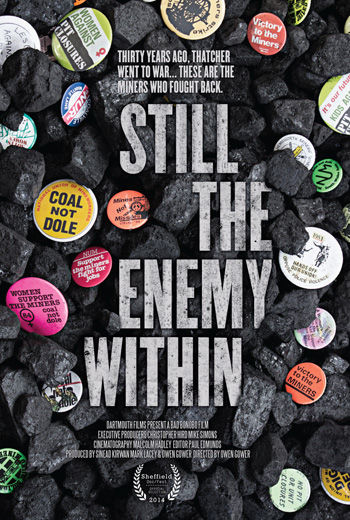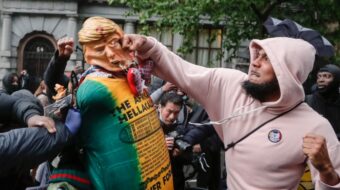
Thirty years after Britain’s mining communities were convulsed by the Great Miners’ Strike, a new documentary about the year-long dispute will be premiered at the Sheffield Documentary Festival on June 7.
In 1984, a conservative government under Prime Minister Margaret Thatcher declared war on the unions, taking on the strongest in the country, the National Union of Mineworkers. Following a secret plan, the government began announcing the closure of coal mines, threatening not just an industry but whole communities and a way of life.
Against all the forces the government could throw at them, 160 000 coal miners took up the fight and became part of a battle that would change the course of history. Still the Enemy Within tells the story of a group of miners and supporters who were on the frontline of the strike for an entire year. These are the people that the media dubbed ‘Arthur’s Army’ and who Margaret Thatcher called ‘the Enemy Within’. Many of them have never spoken on camera before.
Still The Enemy Within is a true labour of love for producers Sinead Kirwan and Mark Lacey and director Owen Gower. Kirwan and Gower have a background in television production for major broadcasters, while Lacey has worked on a number of Oscar-nominated shorts and feature films..
“The real thing was finding a story that we were passionate about, something we would give up a year of our lives to make. In the end it was the strike.”
None of the filmmakers are old enough to remember the strike, although all were aware of the significance of the dispute. “I grew up hearing stories from miners that clashed with the mainstream story that we are told about the strike. We wanted to tell their story,” says Kirwan
Mike Simons, who is executive producer on the project, was a journalist during the strike and wrote two acclaimed books about it, “Striking Back” and “Blood, Sweat and Tears: Photographs from the Great Miners’ Strike.”
Three of the photographers who covered the strike, John Sturrock, John Harris and Martin Shakeshaft, have contributed many powerful images to the film, including some photos that were never developed at the time and will be seen for the first time.
“Our film has a huge amount of unseen archive, or archive that has not been seen in 30 years. There were some amazing films made in 1984-85 that we were the first to request from the archive houses in 30 years. We’ve developed boxes and boxes of negatives from events at the time that have never been developed.”
The central narrators who tell the story of the strike in the film – ordinary miners and the women who organised so much of the support in the community – were in some cases chosen from the photographs, explained Kirwan. These confrontations are described by the participants as they remember them.
“We’ve been making this film for about a year from the point of view of the people who took part in the strike on the frontline.
“The most important thing for us is not about us as filmmakers but the people involved. We try to look at the strike from the position that they could have won. The film doesn’t look back in hindsight but takes us through the strike from the beginning as it actually happened. There is a huge amount of humour and fun in the interviews.
“Although we did talk to experts, we decided not to use them in the end – that kind of approach has been done before. The miners are able to speak eloquently about economics and about how big the stakes were. We wanted people to know what it was like to live through it.”
Miners and miners’ wives and families from Wales, Scotland and Yorkshire feature in the film. “We travelled to a lot of different areas. All of the miners who we hear in some way played quite a significant role, but very much on the ground. So our miner from Scotland was never a union official but he organised pickets right across the Scottish coalfields.”
Getting the film made has been a major challenge, says Kirwan.
Without mainstream funding, they turned to the trade unions and crowd funding and discovered a huge groundswell of interest. “It’s been entirely created by going out to organisations and asking for their support. It’s been a challenging experience but also an amazing one, just to see how important this story is to people.
“The film is totally different from everything else that’s been made about the strike. Every time you show a little bit of the film we get some feedback and that’s been fantastic for us.
“We’ve been overwhelmed by how much support and interest we’ve had from union members and ex-miners, musicians and photographers.”
Ken Loach has supported the project with a donation from his film company, but more importantly, allowing use of archive footage from his films Which Side Are You On? and The Price of Coal.
Kirwan says they are hoping to get mainstream support for the distribution of the film later in the year. “It’s done in the style of a mainstream documentary – we’ve made it visually very beautiful, but it’s all from the point of view of miners. It was an epic confrontation and deserves an epic treatment.”
When the Star met Kirwan at the London Labour Film Festival, she said the production was “picture locked” – that is, the film was finished and in post-production. However she explained that the project still needs significant funding, especially to pay for use of archive from the news houses to clear it for commercial distribution, which is “unbelievably expensive.”
“We’ve had nearly 1,000 people donate to the project, and eight national trade unions. We spent a lot of time going to visit union branches around the country. The response to the film has been incredible.”
After the Sheffield premiere, the filmmakers are planning to have event-led screenings around the country. “Most of the mining areas don’t have independent cinemas so there will be local screenings organised by union branches – 120 branches have said they want to show the film.
“Trade union and individual donations are what have allowed us to get this far, however in order to release the film commercially, put on screenings and release a DVD we need continued support.
“The film will be an essential tool for anyone who wants to stand up to austerity and the current government or simply learn about one of the most dynamic periods in British history.”
To find out more about the film or to make a donation go to: www.the-enemy-within.org.uk/the-film/
The world premiere of Still the Enemy Within is at 1.45pm on June 7 at Sheffield Documentary Festival Showroom 4, then 8.30pm on June 11 at Showroom 4. Also screening on July 13 for the Durham Miners’ Gala at the Durham Miners Hall in Redhill.
Interview reposted from Morning Star.












Comments